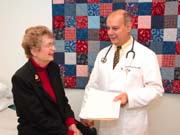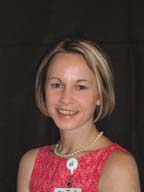A Valentine's
Day
Remembrance
By Margot
Mohsberg
Anne Arundel Medical Center
doctors Karl Holschuh and Howard Young believe that their hospital
is exceptional when it comes to patient care. But it's particularly
nice when someone else realizes it, too.
 Diana
Knodle is now one of those believers, so much so that she and
her husband Tom have vowed to bring doughnuts to Drs. Holschuh
and Young and their staff every Valentine's Day. That's the day
on which they most certainly saved her life. Diana
Knodle is now one of those believers, so much so that she and
her husband Tom have vowed to bring doughnuts to Drs. Holschuh
and Young and their staff every Valentine's Day. That's the day
on which they most certainly saved her life.
"I'm coming back here every Valentine's Day," Tom says. "They
gave me my Valentine back. I know that sounds corny, but it's
true." Feeling healthy is more than just a luxury for a woman
like Diana. It is a necessary way of life. An active lady after
30 years working at office jobs, Diana, 69, "retired" to start
up a farming business. She put up three poultry houses on her
family's property on Maryland's Eastern Shore. Day after day,
for seven years, she rolled up her sleeves and coped with chickens.
It was hard work, but the activity always kept her in good health.
In late December 2002, however, she was feeling poorly enough
to see her general practitioner who started her on a course of
antibiotics. When her labored breathing and headaches failed to
improve, her physician sent her to a nearby community hospital.
She underwent blood work, x-rays and an MRI, but nothing pointed
doctors to a diagnosis. After five days, she was discharged to
go home, where her condition worsened. Climbing the stairs to
her bedroom left her out of breath, and she had no energy to get
through the day. She could eat only tiny quantities of food before
feeling nauseated.
Diana returned to the same emergency room, and this time she was
sent home without being admitted. A few nights later her condition
came to a crisis. At 4 a.m., her husband insisted on taking Diana
to Anne Arundel Medical Center, despite the distance.
"She wanted to go to our local hospital, but I told her, 'We're
going across the bridge,'" Tom says. Diana remembers hallucinating
throughout the two-hour drive.
Dr. Howard Young, the pulmonary/critical care doctor on call to
the emergency department, immediately admitted Diana to the intensive
care unit. He then called Dr. Karl Holschuh, a thoracic surgeon
with AAMC, to come to the hospital.
"When she came to the emergency department, Mrs. Knodle was having
chills and fevers and was in borderline shock. She was in severe
respiratory distress," Dr. Holschuh recalls. Diana's x-ray showed
fluid and air in the pleural space between the lung and its lining,
where air and fluid don't belong. This was the result of an overwhelming
infection.
The x-ray from the previous hospital was reviewed by the pulmonologists,
but at the time it had been taken, "there was nothing to see...,"
Dr. Young says. Diana's condition had deteriorated drastically
in a short period.
With the cause of infection unknown, Diana was put on a broad
spectrum of antibiotics. The medical team inserted a chest tube
through which they drained more than a liter of infected fluid
from her chest. During the terrifying ordeal a humorous moment
occurred when Diana asked Dr. Young if they found any feathers,
the result, perhaps, of her many years tending chicken houses.
The next morning was Valentine's Day 2003, and Diana was told
that she needed an immediate operation. Faith and prayer helped
sustain Diana's family before and during her surgery. "I asked
for a prayer to be said for the doctors," Diana says. "Because
they needed help, too."
According to Dr. Holschuh, Diana's right lower lobe was severely
affected. Much of its tissue was necrotic (dead) and had to be
removed. The procedure took two hours to complete. When the surgery
was done, "she was critically ill," Dr. Holschuh says. "She was
on a ventilator and had a tracheostomy, multiple chest tubes and
a central IV line. She was fed intravenously."
Diana spent nearly a month in the critical care unit. "My family
spent many, many nights at the hospital. And they took wonderful
care of me at Anne Arundel."
What helped her turn the corner? Diana thinks it was the team
approach with the specialists making a decision together, and
the staff's care-giving efforts. She lauds the nursing care as
"absolutely amazing" and recalls the relief she received by the
respiratory therapists and nurses who were there whenever she
needed them.
Diana was reassured by the visibility of the nurses in acute care.
Even when she was unable to talk, she was still able to get their
attention and communicate. Staff made use of an alphabet and word
board, created by Diana's daughter, which she used to spell out
her questions and make her needs clear.
"Smaller hospitals may have the same equipment, but it's the human
resources at Anne Arundel Medical Center that helped get me well,"
Diana says. Dr. Young believes that the 24-hour physician coverage
in the ICU was important.
"There are a lot of eyes on the patients, a lot of people thinking
about her case," he says. "If there's something to find, we find
it." He says the second most important job for AAMC staff was
to support Diana and let her heal and recover.
Diana improved enough to move to a general unit and to be finally
discharged. But her journey to recovery wasn't over. Her next
stop was a rehabilitation facility where she spent another month
re-learning how to sit, stand and eat before she could go home.
Dr. Holschuh believes it was Diana's frequent handling of poultry
that caused her acute illness. "Everybody's theory is that she
contracted some kind of infection from the chicken house," he
says. However, because of the overriding need to get her on antibiotics,
there were never any positive cultures to show association with
exposure to chicken dust.
Dr. Holschuh saw Diana in several follow-up visits. "It was amazing.
Every time she came back she was stronger," he says. By April,
Diana was less weak but still using a walker.
"A month later, in May, she had made tremendous progress," Dr.
Holschuh says. "Her chest x-ray continued to improve with the
clearing of her lung fields. She was no longer using the walker
and her wound was healed." Six months later, Diana was feeling
fine and her chest x-ray was 98 percent clear.
Today, Diana's life is almost, but not quite, back to normal.
She's still working in the poultry houses but in a management
capacity. "My family is adamant that I shouldn't work there at
all, but I still do it," she says. She wears a mask while working
now, to avoid getting dust from the chickens in her lungs.
"Diana Knodle was one of the sickest patients, and one who made
one of the most dramatic recoveries, that I've seen in 30 years
of private practice," Dr. Holschuh says. "[Her recovery] is a
tribute to everyone who worked with her---including her family."
Staying healthy is Diana's goal. "I have another eight years left
on the [poultry house] mortgage," she says. "I have to keep going."
Writer Lisa Esposito contributed to this article.
 Margot Mohsberg is a resident
of Eastport and a freelance writer in addition to being the media
relations associate for Anne Arundel Health System. Margot Mohsberg is a resident
of Eastport and a freelance writer in addition to being the media
relations associate for Anne Arundel Health System.
|
Back
|

